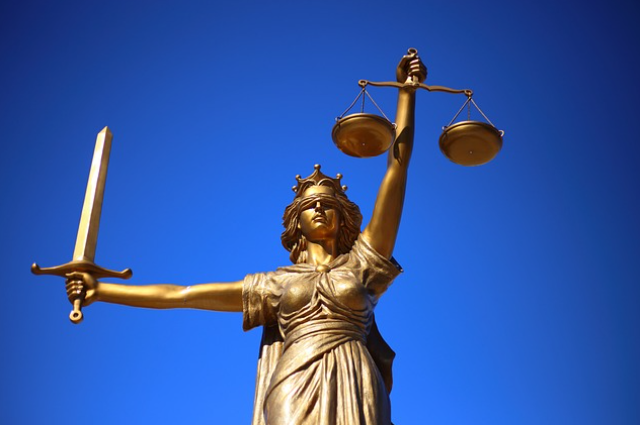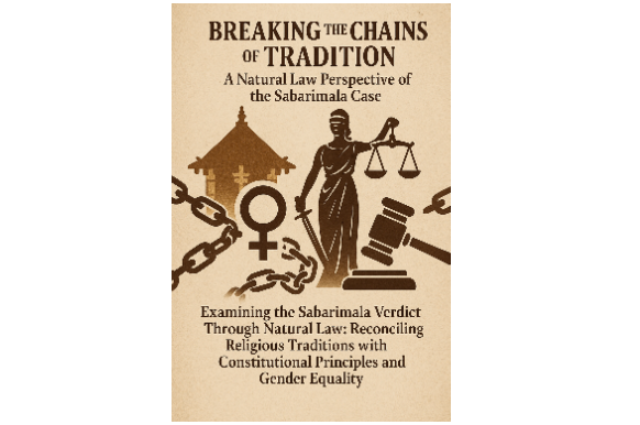
Case Title and Citation:
“Indian Young Lawyers Association v. The State of Kerala & Ors, (2019) 11 SCC 1”
Theory of Jurisprudence:
Natural Law Theory - The basis of the natural law theory depends on the morality, justice, and universal human rights that act as the foundation for the rule of law. According to this theory, rules are also set by the higher moral principles and not just by human authority or customs. The great proponent of Natural Law Theory Thomas Aquinas believed that human rules should be a reflection of the divine law and natural order, whereas philosophers like Aristotle affirmed that the rules must be by reason and the common good. This idea was further expanded by John Locke, asserting that society and the government cannot deny the people their fundamental rights including the right to equality, liberty, and life. It holds that if a law is unjust and unfair then it need not be obeyed if it is in contravention of ethical values.
Summary of the Case Law:
Facts – This is a landmark judgment where the issued involved the restriction on women entering into the Sabarimala Temple who were in their reproductive age between 10-50A petition was filed by the “The Indian Young Lawyers Association” challenging this practice as unconstitutional under Article 14, 15, 17, 21, and 25 of the Indian Constitution. The petitioners argued that the restrictions imposed on the women were discriminatory and this restriction was violative of their fundamental rights. The respondents, including the Travancore Devaswom Board, contended that the prohibition was an essential religious practice that was being protected under Article 25. The Apex Court intervened and discussed essential questions regarding religious freedom, gender equality, and the role of constitutional morality in India.
Issues –
- “If the practice of women aged between 10-50 entering the temple in violation of Articles 14, 15, 17, 21, and 25 of the Constitution”.
- “If the restriction imposed on women is being protected as an essential religious practice under Article 25”.
- “If the religious group has the authority to govern internal matters, including exclusionary practices”.
- “If the exclusion of women amounts to untouchability under Article 17”.
- “If the idea of constitutional morality can overturn the traditions and customs”.
Arguments –
Petitioners:
- Claimed that excluding women is against Article 14's equality clause and Article 15's ban on gender discrimination.
- Claimed that Article 25 does not allow for unconstitutional religious practices and is subject to fundamental rights.
- Asserted that excluding women based on their menstruation violates Article 17's prohibition on untouchability.
- Highlighted the need to use constitutional morality as a compass to solve the problem.
Respondents:
- Claimed that the limitation constituted a necessary religious practice that was covered by Article 25.
- Declared that religious groups are entitled to control their affairs, including how they worship.
- Advised against the overreach of judges in matters of faith.
- Claimed that rather than discriminating against women, the restriction was based on the deity's celibacy.
Judgement:
By the Ration of 4:1, the Supreme Court proclaimed that the restriction imposed on women was unconstitutional and that they could not be denied entry into the temple. Along with Justices R.F. Nariman, A.M. Khanwilkar, and D.Y. Chandrachud, Chief Justice Dipak Misra ruled that this practice violates the fundamental rights of women. In this ruling, Justice Indu Malhotra dissented and declared that the role of the judiciary is not to intervene in religious matters.
- Violation of Fundamental Rights: The Court determined that this practice was discriminatory towards women solely based on gender. It was said that it went against Articles 14 (right to equality) and 15 (prohibition of discrimination).
- Doctrine of Essential Religious Practice: The Court determined that, by Article 25, excluding women from entering the temple cannot be considered an important religious norm. It declared that religious practices had to be in line with the principles of the Constitution.
- Article 17 and Untouchability: According to the Court, the restriction violated Article 17 since it was a kind of discrimination and social exclusion similar to untouchability.
- Constitutional Morality: The Court underlined that religious practices that violate basic rights must yield to constitutional morality.
Analysis:
The basis of the natural law theory is that the laws must be based on the principles of justice, higher moral values, and universal human rights instead of being imposed solely based on traditions and customs. The laws should be just and reasonable, these laws must comply with human dignity, according to philosophers like Aristotle, Thomas Aquinas, and Locke. By overturning the exclusion of women in the Sabarimala case, the Supreme Court put these principles into effect and emphasized that discriminatory practices—regardless of whether they are sanctioned by religion—cannot take precedence over constitutional ideals such as gender equality and human rights.
The Sabarimala ruling confirms that legal systems must change to end societal injustices, much like “Shayara Bano v. Union of India (2017)”, which outlawed instant triple talaq, and “Navtej Singh Johar v. Union of India (2018)”, which decriminalized homosexuality. The Court's emphasis on constitutional morality is consistent with the idea of natural law, which holds that legislation should promote justice and equity rather than mindlessly preserving antiquated customs.
1. Aquinas and rational morality:
Superior moral principles over social practices-
- Thomas Aquinas, a key figure in natural law, proposed a hierarchy of laws, which he called eternal law (God's purpose), divine law (scripture revealed), natural law (the understanding of eternal law by human reason), and human law (positive law).
- He maintained that natural law is the source of legitimacy for human law. It is referred to as a "perversion of law" when human law conflicts with "natural law."
- The higher moral ideals enshrined in the Indian Constitution, which can be interpreted as representing the nation's contemporary natural law, were used to challenge the traditional ban, which was codified as a "customary law" inside the temple's practices, in the Sabarimala case.
Natural law places more emphasis on rationality than on custom –
- Modern scientific and ethical understandings do not rationally support the exclusion of women based on ideas of "impurity" during menstruation.
- The Supreme Court's ruling emphasizes that traditions, no matter how long-standing, cannot excuse discrimination if they are not supported by reason or morality.
- For instance, it is superstitious and not logical to claim that a woman who is menstruating will make the deity lose its celibacy. Natural law necessitates reason.
Common Good-
- Aquinas likewise emphasized the "common good" as the goal of the law. Instead of advancing the common good, the exclusion of women exacerbates gender inequality and jeopardizes the welfare of a sizable segment of the population.
- The court is advancing the general welfare by permitting worship by all devotees.
2. Gender Equality as a Universal Right (Locke and Inalienable Rights)
Locke's State of Nature and Natural Rights-
- The foundation for contemporary human rights was established by John Locke's theory of natural rights, which includes life, liberty, and property.
- He maintained that these rights are intrinsic to every person and exist in a "state of nature" that is unaffected by social contracts or governments.
- Locke's idea of natural rights can be extended in the Sabarimala case by the right to worship, which is an expression of religious liberty.
Equality as an Inalienable Right-
- In this situation, gender equality ceases to be a socially bestowed privilege and instead becomes an inalienable right.
- The Supreme Court's ruling upholds that women's right to worship is an essential component of their human dignity and is not dependent on religious interpretation or social approval.
- For instance, the freedom to worship is a human right that exists independently of government approval.
Contesting Patriarchal Interpretations-
- The decision contests patriarchal readings of religious doctrine and customs that have traditionally been used to defend gender inequity.
- It states that the interpretation of religious freedom must take into account each person's fundamental rights.
3. Using Morality from the Constitution
- Constitutional Morality as Contemporary Natural Law: A framework for interpreting and applying constitutional concepts in a manner consistent with core moral ideas, "constitutional morality" can be seen as a contemporary expression of natural law.
- It places a strong emphasis on following the Constitution's spirit, especially when it goes against conventional wisdom.
- Constitutional morality involves more than just abiding by the text of the Constitution; it also involves abiding by its purpose.
4. Legal Reform and Social Progress
Law as a Tool for Social Change-
- By Natural Law Theory, the laws are to be used for the advancement of the principles of equality and justice in society.
- The landmark ruling in the Sabarimala Temple Case showcases how societal development can be implemented effectively to challenge discriminatory practices through legal reforms.
Reflecting Modern Values-
- The representation of the modern perspective of equality and justice can be achieved if the laws are changed. The Court's decisions acknowledged the necessity of protecting the groups that are excluded from society.
Challenging Static Interpretations-
- The decision played an important role emphasizing that discrimination should not be excused by religious freedom, challenging static interpretations of religious traditions.
- The ruling of the court gave a vibrant interpretation of religious norms that are inconsistent with the values of justice and equality.
- The court stated that religion should be practiced in a way that is in harmony with contemporary society and where every human being can freely exercise their fundamental rights. The religion should not act as an evil.

List of References (Bluebook 21st ed.)
- Indian Young Lawyers Ass'n v. State of Kerala, (2019) 11 SCC 1.
- Upendra Baxi, "Constitutional Morality and Judicial Activism: The Supreme Court’s Role in Transforming India," 32 Ind. J. Const. L. 45 (2018).
- Granville Austin, The Indian Constitution: Cornerstone of a Nation (Oxford University Press 1999).
- John Finnis, Natural Law and Natural Rights (Oxford University Press 1980).
- Thomas Aquinas, Summa Theologica, trans. Alfred J. Freddoso (Hackett Publishing 1997).
- John Locke, Two Treatises of Government (Cambridge University Press 1988).
